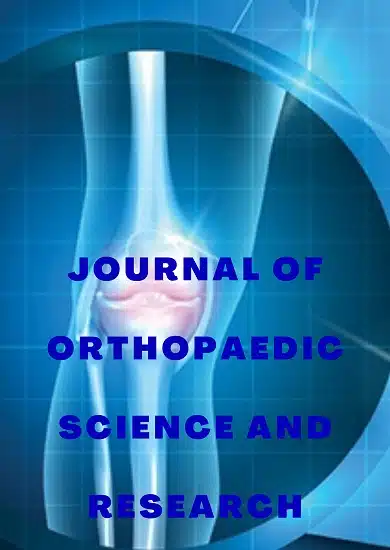Research Article | Vol. 6, Issue 1 | Journal of Orthopaedic Science and Research | Open Access |
Are Evaluation Scores Reliable Predictors of 30-Day and 1-Year Mortality in Fragility Neck of Femur Fractures?
Efthymios Iliopoulos1*, Reichan Molla Moustafa1, Ioannis Kougioumtzis1, Konstantinos Tilkeridis1, Athanasios Ververidis1, Georgios Drosos1
1Metabolic Disease and Fragility Fractures Unit of Academic Department of Orthopaedics in General University Hospital of Alexandroupolis, Democritus University of Thrace, Greece
*Correspondence author: Efthymios Iliopoulos, MD, MBA(HSM), PhD, CCST(T&O), Assistant professor of Orthopaedics, Democritus University of Thrace, Greece; Email: [email protected]
Citation: Iliopoulos E, et al. Are Evaluation Scores Reliable Predictors of 30-Day and 1-Year Mortality in Fragility Neck of Femur Fractures? J Ortho Sci Res. 2025;6(1):1-6.
Copyright© 2025 by Iliopoulos E, et al. All rights reserved. This is an open access article distributed under the terms of the Creative Commons Attribution License, which permits unrestricted use, distribution, and reproduction in any medium, provided the original author and source are credited.
| Received 04 March, 2025 | Accepted 24 March, 2025 | Published 31 March, 2025 |
Abstract
Introduction: An aging population is one major concern of healthcare providers, with fragility fractures affecting individuals over the age of 65. While there are multiple tests available for predicting mortality, we have yet to define the best clinical assessment tool for fragility fractures.
Material and Methods: All patients admitted in our hospital from 2017 until 2023 with fragility NOF fracture were included in the study. The collected data included demographic data and several scales, included the AMTS score, the new mobility score, the ASA grade, the Charlson Index, the Nottingham Hip Fracture score and the Sernbo score. The 30 day mortality was collected as well. Patients without full data were removed from the study.
Results: There were 380 patients forming the study cohort and after exclusions a total of 356 patients aged 81.73± 9.24 years, with fragility neck of femur fractures were finally included in the study. The patients had mean ASA grade of 2.36±0.6, while pre-operatively the NMS score was 5.77±2.6, the Charlson Score 4.17±2.3, the NHFS 5±1.2 and the Sernbo score 15.23±3.8. The 30-day mortality was 9.5% and the 1-year mortality was 28.8%.
In the multivariant model with the 30-day mortality as dependent variable, all variables lose their unique significance. In the multivariant model with the 1 year mortality as dependent variable the only variable that retained its significance as independent predictive factor after a fragility neck of femur fracture was the new mobility score (p=0.024).
Conclusion: The multivariant analysis of the present study revealed that New Mobility Score is the only independent predictive risk factors for 1 year mortality after a fragility hip fracture. Although the Sernbo and NHFS scores are useful, they do not appear to predict the 30-day and the 1 year mortality of the patients in this cohort.
Keywords: Fragility Fracture; Mortality Prediction; New Mobility Score; Nottingham Hip Fracture Score; Abbreviated Mental Test Score; PROMs
Introduction
Frailty poses a major challenge to healthcare providers. Globally the incidence of hip fracture estimated to increase, as it is projected that the total number is going to reach 6.3 million until 2050 [1]. Fragility fractures affecting individuals over the age of 65, frequently coexist with sarcopenia, frailty and malnutrition. These can lead to complications, resulting to loss of independence and has a substantial incidence of mortality and morbidity. The postoperative mortality rate of hip fractures is 5-10% at 30 day and 19-33% at 1 year [2-4].
The identification of patients with a high risk of complications and mortality is essential in order to provide more tailored services to these patients. The last years many scores have been identified for this purpose. Frequently used postoperative outcome measurement tools include the American Society of Anesthesiology (ASA) score, Charlson Comorbidity Index (CCI), Nottingham Hip Fracture Score (NHFS), Abbreviated Mental Test Score (AMTS), Orthopedic-Physiological and Operative Severity Score for the enumeration of Mortality and Morbidity (O-POSSUM), Estimation of Physiologic Ability and Surgical Stress (E-PASS), Mini-Mental State Examination (MMSE), Risk Model for Delirium (RD) and Barthel Index [5]. The new mobility score assesses pre-fracture mobility status and has good predictive ability for mortality [6]. Sernbo is an additional test which was created recently to aid the decision making for surgery type following femoral neck fracture. At the same time, it was found that it had a good predictive ability for mortality [7].
The aim of the present study is to evaluate the value of using the Sernbo score as a mortality predictor factor for fragility hip fractures. With the view to choose the most useful, quick and reliable clinical assessment tool that can help identify high-risk patients with an increased rate of mortality and morbidity.
Material and Methods
All elderly patients (>65yo) admitted in the Trauma and Orthopaedics Department of the General University hospital from July 2017 until June 2023 with fragility neck of femur fracture were included in the study. Younger patients (<65yo) and patients with high energy trauma patients with incomplete data were excluded from the study. The data were collected prospectively and anonymized for the local registry and analyzed retrospectively for the purpose of the present study. The collected data included demographic data and several scales, included the mental state (Abbreviated Mental Test Score, AMTS), the mobility state (New Mobility Score, NMS), the physical condition preoperatively (American Society of Anesthesiologists, ASA), the assessment of co-morbidity (Charlson Index), the risk of mortality (Nottingham Hip Fracture score, NHFS) and the survival (Sernbo score). The 30-day and one-year mortality was collected as well.
This research has been approved by the authors’ affiliated institutions. Informed consent was obtained from all patients and relevant persons for publication. No identifiable information of the participants is included in the manuscript. Statistical analysis was performed using the SPSS version 23.0 statistical program (SPSS Inc., Chicago, IL, USA) and the statistical significance was set at the 0.05.
Results
A total of 380 patients were included in the study. After exclusions a total of 356 patients aged 81.73±9.24 years, with fragility neck of femur fractures were included in the study. Most of the patients (71%) were female and the mean BMI of the cohort was 26.66±4.91. The patients had mean ASA grade of 2.36±0.6, while pre-operatively the NMS score was 5.77±2.6, the Charlson Score 4.17±2.3, the NHFS 5±1.2 and the Sernbo score 15.23±3.8. The 30-day mortality was 9.5% and the 1-year mortality was 28.8%. Table 1 summarizes these results.
The monovariant analysis revealed that Gender had significant influence on the 30-day mortality (p=0.05). Age, BMI, AMTS, ASA grade, New Mobility Score, Charlson Index, NHFS and Sernbo Score did not affect significantly the 30-day mortality rate (p=0.12, 0.41, 0.42, 0.98, 0.43, 0.94, 0.21 and 0.75 respectively) (Table 2).
The one year mortality was related significantly with AMTS, New Mobility Score, NHFS (p=0.03, 0.003, 0.017 respectively). Gender, Age, BMI, ASA grade, Charlson Index and Sernbo Score did not have significant influence at the one year mortality (p=0.06, 0.63, 0.16, 0.57, 0.82 and 0.07 respectively) (Table 3).
In the multivariant model with the 30-day mortality as dependent variable, all variables lose their unique significance. In the multivariant model with the 1 year mortality as dependent variable the only variable that retained its significance as independent predictive factor after a fragility neck of femur fracture was the new mobility score (p=0.024) (Table 4).
| Frequencies (N) | Percent (%) | Mean ±SD |
Age | 81.73 ±9.2 | ||
BMI | 26.66 ±4.9 | ||
Gender | |||
Female | 254 | 71.3 | |
Male | 102 | 28.7 | |
ASA Grade | 2.36 ±0.6 | ||
New Mobility Score | 5.77 ±2.6 | ||
Charlson Score | 4.17 ±2.3 | ||
Nottingham Hip Fracture score | 5 ±1.2 | ||
Sernbo score | 15.23 ±3.8 | ||
30-day Mortality | |||
Alive | 315 | 90.5 | |
Death | 33 | 9.5 | |
1-year Mortality | |||
Alive | 200 | 71.2 | |
Death | 81 | 28.8 |
Table 1: Descriptives, pre-operative scores and mortality data of the cohort.
| Mean ±SD | p value | ||||
Gender | Female | Male | 0.05 | |||
30-day mortality: Alive | 232 | 83 | ||||
30-day mortality: Death | 19 | 14 | ||||
Age | 0.12 | |||||
30-day mortality: Alive | 81.53 ±9.2 | |||||
30-day mortality: Death | 83.88 ±8.4 | |||||
BMI | 0.16 | |||||
30-day mortality: Alive | 27.09 ±5.2 | |||||
30-day mortality: Death | 26.13 ±4.4 | |||||
ASA grade | Grade I | Grade II | Grade III | Grade IV | 0.98 | |
30-day mortality: Alive | 14 | 190 | 92 | 17 | ||
30-day mortality: Death | 1 | 20 | 10 | 2 | ||
AMTS | 042 | |||||
30-day mortality: Alive | 7.34 ±2.7 | |||||
30-day mortality: Death | 6.82 ±3.0 | |||||
New Mobility Score | 0.43 | |||||
30-day mortality: Alive | 5.71 ±2.6 | |||||
30-day mortality: Death | 6.15 ±2.7 | |||||
Charlson Index | 0.94 | |||||
30-day mortality: Alive | 4.15 ±2.3 | |||||
30-day mortality: Death | 4.15 ±2.5 | |||||
Nottinham Hip Fracture Score | 0.21 | |||||
30-day mortality: Alive | 4.97 ±1.2 | |||||
30-day mortality: Death | 5.27 ±1.7 | |||||
Sernbo Score | 0.75 | |||||
30-day mortality: Alive | 15.23 ±3.7 | |||||
30-day mortality: Death | 14.97 ±3.8 | |||||
Table 2: Monovariant analysis of 30-day mortality.
| Mean ±SD | p value | ||||
Gender | Female | Male | 0.63 | |||
1-year mortality: Alive | 144 | 56 | ||||
1-year mortality: Death | 56 | 25 | ||||
Age | 0.06 | |||||
1-year mortality: Alive | 80.61 ±9.5 | |||||
1-year mortality: Death | 82.69 ±9.2 | |||||
BMI | 0.024 | |||||
1-year mortality: Alive | 27.24 ±4.8 | |||||
1-year mortality: Death | 26.11 ±5.1 | |||||
ASA grade | Grade I | Grade II | Grade III | Grade IV | 0.57 | |
1-year mortality: Alive | 12 | 124 | 51 | 11 | ||
1-year mortality: Death | 3 | 55 | 21 | 2 | ||
AMTS | 0.03 | |||||
1-year mortality: Alive | 7.60 ±2.6 | |||||
1-year mortality: Death | 6.63 ±3.2 | |||||
New Mobility Score | 0.003 | |||||
1-year mortality: Alive | 6.28 ±2.6 | |||||
1-year mortality: Death | 5.28 ±2.7 | |||||
Charlson Index | 0.82 | |||||
1-year mortality: Alive | 3.72 ±2.2 | |||||
1-year mortality: Death | 3.75 ±2.43 | |||||
Nottinham Hip Fracture Score | 0.017 | |||||
1-year mortality: Alive | 4.82 ±1.1 | |||||
1-year mortality: Death | 5.20 ±1.3 | |||||
Sernbo Score | 0.07 | |||||
1-year mortality: Alive | 15.88 ±3.6 | |||||
1-year mortality: Death | 15.15 ±3.4 | |||||
Table 3: Monovariant analysis of one year mortality.
| Significance (p) for 30-day mortality | Beta | Significance (p) for 1 year mortality | Beta |
Age | 0.190 | 1.037 | 0.666 | 1.008 |
BMI | 0.642 | 0.981 | 0.378 | 0.973 |
Gender | 0.116 | 1.923 | 0.956 | 1.018 |
ASA Grade | 0.515 | 1.234 | 0.33 | 0.789 |
New Mobility Score | 0.105 | 1.166 | 0.024* | 0.865 |
Charlson Score | 0.970 | 1.003 | 0.823 | 0.985 |
Nottingham Hip Fracture score | 0.687 | 1.080 | 0.294 | 1.170 |
Sernbo score | 0.963 | 1.004 | 0.338 | 1.059 |
Table 4: Multivariant analysis results for 30-day and 1 year mortality (significant score is marked with *).
Discussion
The present study demonstrates the importance of the use of different evaluation scores as mortality prediction tools for patients sustaining a fragility neck of femur fracture. From the scores used the new mobility score had the most significant predictive capability for the one year survival. The NHFS, the AMTS and the age were other factors related with the mortality.
The Nottingham Hip Fracture Score (NHFS) was created for mortality prediction in fragility fracture of the hip in 2008. It includes an assessment of seven variables: age, sex, co-morbidities, hemoglobin concentration, cognitive status evaluation with AMTS, living arrangements and history of malignancy [8]. The 30-day prediction ability has been validated separately and in many countries [9-11]. However, the one year mortality rate was significantly related to the NHFS. Other studies, besides using of 30-day and one-year mortality rates, examine the score for early hospital discharge [12]. In contrast to our study, Nelson M, et al., 2020 demonstrated the good predictive ability of the score for 30 days , 6 months and one year mortality (p=0.001), but the number of patients included in their retrospective data collection was only 130 compared to the 380 of the present study [13]. Reports from some European countries suggest that the NHFS may underestimate mortality in specific cohorts of patients with fragility hip fractures. To address these variations, certain amendments have been proposed to better account for individual differences in these countries [14,15]. It is possible that the Greek cohort exhibits similar discrepancies, indicating that the NHFS could be adjusted to better suit local needs.
The Sernbo score was initially created to assist in deciding whether you choose total or hemi arthroplasty for femoral neck fractures [7]. Later it was found that this score also has one-year mortality prediction ability [16]. However, in our study, Sernbo did not show prediction ability for one-year mortality. It should be mentioned that we used it for all hip fractures, whereas it was specifically designed for femoral neck fractures and this may have influenced our results. In a study by Mellner, et al., 2021, the use of Sernbo score reliably predicted the one-year mortality in the Swedish national registry, which included all hip fractures in the elderly [16]. Further studies in other countries could clarify if this score has different predictive values in different cohorts.
The mobility status before the frailty fracture it is attended to be most reliable predictor of recovery after the fracture in the geriatric population [6,17,18]. Another study establishes that patients with walking ability without assistance before surgery live longer up to 1 year and ten years (p<0.001) [19]. The new mobility score was created for mortality prediction by assessing the mobility status in various conditions such as at home, outside and shopping abilities [20]. Α prospective study with 280 patients shows the mobility status, which was evaluated with new mobility score, is a self-sufficient predictor for early postoperative outcomes during hospitalization . In the present study, the NMS had predictive ability for one-year mortality only in monovariant analysis. It is crucial to note that while all scores lose their significance in multivariate analysis only the NMS had predictive ability as a score. This result is consistent with the literature so far [6,20,21].
The mobility status before the frailty fracture it is attended to be most reliable predictor of recovery after the fracture in the geriatric population [6,17,18]. Another study establishes that patients with walking ability without assistance before surgery live longer up to 1 year and ten years (p<0.001) [19]. The new mobility score was created for mortality prediction by assessing the mobility status in various conditions such as at home, outside and shopping abilities [20]. Α prospective study with 280 patients shows the mobility status, which was evaluated with new mobility score, is a self-sufficient predictor for early postoperative outcomes during hospitalization . In the present study, the NMS had predictive ability for one-year mortality only in monovariant analysis. It is crucial to note that while all scores lose their significance in multivariate analysis only the NMS had predictive ability as a score. This result is consistent with the literature so far [6,20,21].
Conclusion
Patients with fragility neck of femur fractures have high mortality risk. Different evaluation scores can be proven useful tools in the prediction of survival for these patients. The present study by using multivariant analysis, revealed that the new mobility score is the only independent predictive risk factors for 1 year mortality after a fragility hip fracture in the Greek population. Further studies should evaluate the predictive ability of mortality of other evaluation scores.
Conflict of Interests
As participants in this study, we collectively declare that none of us have any financial, personal or professional conflicts of interest that could inappropriately influence or appear to influence, the conduct, outcomes or reporting of this research.
Funding/Sponsorship
Not applicable
References
- Cooper C, Campion G, Melton LJ. Hip fractures in the elderly: A world-wide projection. Osteoporos Int. 1992;2:285-9.
- Braithwaite RS, Col NF, Wong JB. Estimating hip fracture morbidity, mortality and costs. J Am Geriatr Soc. 2003;51(3):364-70.
- Brauer CA, Coca-Perraillon M, Cutler DM, Rosen AB. Incidence and mortality of hip fractures in the United States. JAMA. 2009;302(14):1573-9.
- Inoue T, Maeda K, Nagano A, Shimizu A, Ueshima J, Murotani K, et al. Undernutrition, sarcopenia and frailty in fragility hip fracture: Advanced strategies for improving clinical outcomes. Nutrients. 2020;12(12):3743.
- Marufu TC, Mannings A, Moppett IK. Risk scoring models for predicting peri-operative morbidity and mortality in people with fragility hip fractures: Qualitative systematic review. Injury. 2015;46(12):2325-34.
- Parker MJ, Palmer CR. A new mobility score for predicting mortality after hip fracture. J Bone Jt Surg Br Vol. 1993;75(5):797-8.
- Mellner C, Eisler T, Börsbo J, Brodén C, Morberg P, Mukka S. The Sernbo score predicts 1-year mortality after displaced femoral neck fractures treated with a hip arthroplasty. Acta Orthop. 2017;88(4):402-6.
- Maxwell MJ, Moran CG, Moppett IK. Development and validation of a preoperative scoring system to predict 30 day mortality in patients undergoing hip fracture surgery. Br J Anaesth. 2008;101(4):511-7.
- Karres J, Heesakkers NA, Ultee JM, Vrouenraets BC. Predicting 30-day mortality following hip fracture surgery: evaluation of six risk prediction models. Injury. 2015;46(2):371-7.
- Kau CY, Kwek EB. Can preoperative scoring systems be applied to Asian hip fracture populations? Validation of the Nottingham Hip Fracture Score (NHFS) and identification of preoperative risk factors in hip fractures. Ann Acad Med Singapore. 2014;43(9):448-53.
- Tilkeridis K, Ververidis A, Kiziridis G, Kotzamitelos D, Galiatsatos D, Mavropoulos R, et al. Validity of Nottingham hip fracture score in different health systems and a new modified version validated to the Greek population. Med Sci Monit Int Med J Exp Clin Res. 2018;24:7665.
- Moppett IK, Wiles MD, Moran CG, Sahota O. The Nottingham Hip Fracture Score as a predictor of early discharge following fractured neck of femur. Age Ageing. 2012;41(3):322-6.
- Nelson MJ, Scott J, Sivalingam P. Evaluation of Nottingham hip fracture score, age-adjusted Charlson comorbidity index and the physiological and operative severity score for the enumeration of mortality and morbidity as predictors of mortality in elderly neck of femur fracture patients. SAGE open Med. 2020;8:2050312120918268.
- De Jong L, Klem TM, Kuijper TM, Roukema GR. Validation of the Nottingham Hip Fracture Score (NHFS) to predict 30-day mortality in patients with an intracapsular hip fracture. Orthop Traumatol Surg Res. 2019;105(3):485-9.
- Olsen F, Lundborg F, Kristiansson J, Hård af Segerstad M, Ricksten S, Nellgård B. Validation of the Nottingham Hip Fracture Score (NHFS) for the prediction of 30‐day mortality in a Swedish cohort of hip fractures. Acta Anaesthesiol Scand. 2021;65(10):1413-20.
- Mellner C, Hedström M, Hommel A, Sköldenberg O, Eisler T, Mukka S. The Sernbo score as a predictor of 1-year mortality after hip fracture: a registry study on 55,716 patients. Eur J Trauma Emerg Surg. 2021;47:2043-8.
- Cree AK, Nade S. How to predict return to the community after fractured proximal femur in the elderly. Aust N Z J Surg. 1999;69(10):723-5.
- Thorngren K-G, Norrman P-O, Hommel A, Cedervall M, Thorngren J, Wingstrand H. Influence of age, sex, fracture type and pre-fracture living on rehabilitation pattern after hip fracture in the elderly. Disabil Rehabil. 2005;27(18-19):1091-7.
- Iosifidis M, Iliopoulos E, Panagiotou A, Apostolidis K, Traios S, Giantsis G. Walking ability before and after a hip fracture in elderly predict greater long-term survivorship. J Orthop Sci. 2016;21(1):48-52.
- Kristensen MT, Foss NB, Ekdahl C, Kehlet H. Prefracture functional level evaluated by the New Mobility Score predicts in-hospital outcome after hip fracture surgery. Acta Orthop. 2010;81(3):296-302.
- Pedersen TJ, Lauritsen JM. Routine functional assessment for hip fracture patients: Are there sufficient predictive properties for subgroup identification in treatment and rehabilitation? Acta Orthop. 2016;87(4):374-9.
Author Info
Efthymios Iliopoulos1*, Reichan Molla Moustafa1, Ioannis Kougioumtzis1, Konstantinos Tilkeridis1, Athanasios Ververidis1, Georgios Drosos1
1Metabolic Disease and Fragility Fractures Unit of Academic Department of Orthopaedics in General University Hospital of Alexandroupolis, Democritus University of Thrace, Greece
*Correspondence author: Efthymios Iliopoulos, MD, MBA(HSM), PhD, CCST(T&O), Assistant professor of Orthopaedics, Democritus University of Thrace, Greece; Email: [email protected]
Copyright
Efthymios Iliopoulos1*, Reichan Molla Moustafa1, Ioannis Kougioumtzis1, Konstantinos Tilkeridis1, Athanasios Ververidis1, Georgios Drosos1
1Metabolic Disease and Fragility Fractures Unit of Academic Department of Orthopaedics in General University Hospital of Alexandroupolis, Democritus University of Thrace, Greece
*Correspondence author: Efthymios Iliopoulos, MD, MBA(HSM), PhD, CCST(T&O), Assistant professor of Orthopaedics, Democritus University of Thrace, Greece; Email: [email protected]
Copyright© 2025 by Iliopoulos E, et al. All rights reserved. This is an open access article distributed under the terms of the Creative Commons Attribution License, which permits unrestricted use, distribution, and reproduction in any medium, provided the original author and source are credited.
Citation
Citation: Iliopoulos E, et al. Are Evaluation Scores Reliable Predictors of 30-Day and 1-Year Mortality in Fragility Neck of Femur Fractures? J Ortho Sci Res. 2025;6(1):1-6.



